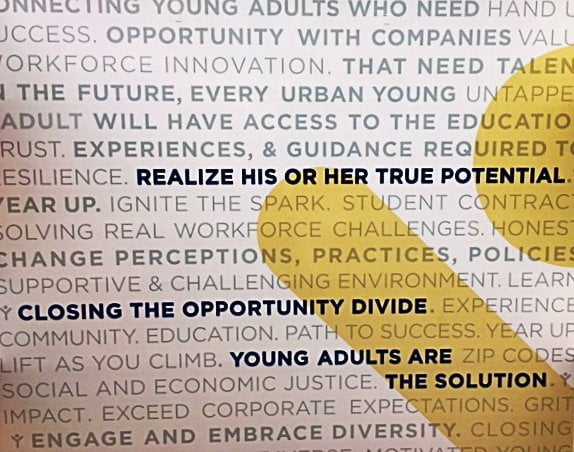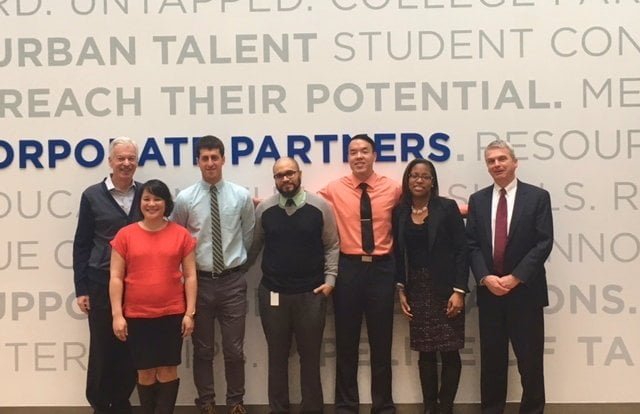Better Than Most is a regular feature of The Business of Giving examining the best places to work among social businesses and nonprofit organizations.
Denver: One of the most popular guests we’ve had on the show was Gerald Chertavian, the Chief Executive Officer of Year Up. And this evening, you’ll be going up to their headquarters located in the financial district of Boston. We’ll start with John Bradley, their Chief Operating Officer who will tell us about Year Up and then we’ll hear from other members of the team.

John: So Year Up is going into year 17-plus. The great news is the mission is as we started the mission. It is very much about making sure that we are an organization that is really effective at taking opportunity to youth, giving them the opportunity to have access to great learning, great internship opportunities with a guide towards better employment, and an opportunity to pursue educational outcomes that they deserve and so rarely get.
Bob: I think there’s a unique culture here at Year Up. I think it’s unique because we’re a mission-driven organization and one of the things that’s really important, especially as we get bigger and we scale up, is that we want all of the employees connected to our students, so some level of student experience. I think that helps to drive a lot of the culture here. So you see around the room, you’d see things like core values. The core values in all the conference rooms and around the workplace, but they’re also in the classrooms with the students, so we’re all collectively kind of living by those.
Jonathan: The last thing I’ll mention is that having come from a public sector where mentorship is kind of ad hoc or it doesn’t always happen, I think having a culture where it’s really emphasizing, for our students, having mentors but also providing not just feedback, but having great managers who are able to be mentors and help me deepen my knowledge and skill set and my capacity to be a thought leader in the field. I really appreciated just getting a diverse set of more people from different backgrounds that I’ve come from being able to really help build my capacity to be better at what I do.
Elaine: All the staff really are very, very focused together on our mission and on our students. And the reason why that happens I believe, is because every staff, whether you’re an executive director or on the marketing team, traditionally non-direct service type roles, we still have roles involved with students, so all of us are still mentoring students, coaching students on a daily, weekly basis. And so whenever those tough moments come in where tough decisions need to be made, the students are kind of our north star, so we’re always able to kind of go back to what is best for the students, what decision would be most in line with our core values, how do we really live out what we are teaching our students to do. That’s where feedback really comes into place. If we’re teaching our students about how to give and receive feedback in a productive way then we, as staff, also have to live that.
Jose: One of the things that really stood out to me when I first did the program as a student was how fully vested and committed the whole staff was and what a really family environment it was. In the beginning, for me it was almost unreal. I almost asked myself “Is this serious?” I caught myself asking “What’s the catch?” But as I went along with the program I really started to notice that everyone really cared. Everyone really wanted to see me succeed. Everybody really wanted to give me the tools that I didn’t necessarily have coming into the program to take into corporate America.
Tyra: For me the feedback is just evident every single day, how important and intentional it is. It can happen in the elevator running into the CEO and saying “Hey, what feedback do you have for me?” Or “We’re rolling this initiative out, what do you think about it?” So really being prepared to offer the thoughts and feedback on that in the moment. We live on Plus/Deltas for every single meeting, group function. We talked about it constantly, consistently. We even have it in the calendar as “It’s feedback week. Make sure you’re giving someone feedback.” I think what’s incredible about Year Up is the fact that we do it with our students once a week in a big room setting, in a big circle and it’s given publicly to really ensure accountability. I as a staff member, I can get feedback from a student of “This is what you did well this week and this is where you really didn’t hit the mark.” Then I have to own that and sit in that at the moment and just listen and absorb and not respond because that’s our feedback model.

Year Up Wall
John: There’s a phrase that we use and we rely on, and the phrase is, “We don’t care what you know until we know how much you care.” It sounds a little bit trite but, honestly, there’s a lot of work here that isn’t rocket science and we can train and help people in. What we can’t do is help people get mission-connected. We can’t help them sort of like this culture. It is very different from anywhere I’ve ever been. It’s excitingly different, but it doesn’t work for everybody. And it’s important to make sure that we get people who are effective, efficient, productive, and excited in this environment.
Bob: It probably starts with the mission. You’ve got to be mission-aligned, but then it’s also what you bring from a functional and expertise perspective. We go through a very rigorous process to vet candidates. They actually meet with students. They meet with other staff members. So there’s probably four or five different interview cycles that we go through to vet a person and make sure that they’re aligned. We have metrics, we measure folks in terms of their performance and how they do with this on-going feedback. Those are really important pieces of the process.
Elaine: The first is performance review. I first started working at Year Up seven years ago and up until that point, I had never had a performance review that felt useful to me. It was always kind of, “You’re doing great. Keep doing what you’re doing.” “Okay, great!” It was just kind of checking a box. My first performance review at Year Up I really remembered it because it was about 12 pages of feedback for me, that was very useful, it was very specific. As Tyra said we try to be balanced, but we also try to be specific and we try to make sure that it’s coming from a caring place. This was feedback from not only my manager, it was from people that reported to me, it was from peers on other teams. And I really, in looking at the quality of the comments and the spirit of the comments felt like each person took it so seriously. Spent a lot of time to offer me feedback of “What can I tell Elaine that’s going to make her a stronger leader, a stronger employee that’s going to help her in her career.”
Jose: For me I would say is that on any given day you can have our CEO, Gerald, walk by your desk, come shake your hand, ask you about your weekend, how your day is going. And to me I haven’t really worked for any CEOs like that that were reachable and would want to talk to you and have a conversation about you genuinely. So I think that’s something great that he does, it’s a real tone setter. I think it definitely gets everybody else in a great mood and definitely motivates everybody else to kind of reach out to different people, walk around the building, talk to somebody on the elevator, at lunch go for walks, things of that nature.
Terence: It almost feels like it’s on-going but it’s all in the spirit of developing the employee. I’ve been here for almost six years and it’s like you haven’t seen it all, you haven’t done it all because it’s just this continuous cycle of improvement and investment. And because of this organization just keeps growing, there’s always opportunity. You’ll never kind of get settled because the company is always moving and shifting in different ways that you never thought possible.
Tyra: There are areas about diversity when you think about our staff make up and hiring where we know we can do better, we’re not where we want to be, but we don’t shy away from even talking about that, being transparent around “This is what diversity looks like on a leadership level.” “This is what our board looks like.” “This is what we want it to look like.” This is our strategy to get to where we want to be.” We don’t shy away from those conversations. I think what’s interesting too is we treat our staff and students with the same respect as well as around how important diversity is and for us to engage in important dialogues.
John: The other thing we do, and it’s not strictly related to recognition but it helps people feel recognized, is we still have a sabbatical program. So everybody who is with us for six years gets to take either a four-week or an eight-week, and some of it is paid and some of it is unpaid, sabbatical. And the only requirement is it needs to– and you can think creatively about how you get there but somehow, it needs to be connected to the mission of helping opportunity and youth connect better with talent pipeline. And we do it not only the first six years, but every six years you’re here.

Denver: I want to thank Tiffany Perez for organising my visit and to all those who participated: Bob Dame, Jonathan Hasak, Elaine Chow, Jose Castillo, Terrence Chan, Tyra Anderson-Montina and John Bradley. You can hear this audio again, read the transcript and see pictures of the participants in the Year Up offices just by going to denverfrederick.wordpress.com where we will also have a link to my full interview with Gerald Chertavian, their CEO.
The Business of Giving can be heard every Sunday evening between 6:00 p.m. and 7:00 p.m. Eastern on AM 970 The Answer in New York and on iHeartRadio. You can follow us @bizofgive on Twitter, @bizofgive on Instagram and at www.facebook.com/BusinessOfGiving

